Those who have the Ender 3 / Ender 3 Pro knows how this is an excellent printer, with great accuracy, and managed at this price tag to have only 3 things sacrificed:
print speed : not a concern when buying a budget printer, and anyways not so bad at all.
lack of auto-mesh bed levelling : can be easily solved by adding the BLtouch upgrade. Anyways with this small build volume and a reliable frame it isn't too much a concern.
silence : yes, with the noisy stepper motor drivers, the extruder fan, and most of all the power supply is really noisy.
While searching for replacement power supplies, or upgrades to the stock ones, came across many variations of the case to replace the stock 40mm fan by a larger one (or none), among them were:
full honeycomb, no fan at all (won't take the risk): https://www.reddit.com/r/ender3/comments/dz62qv/i_have_a_silent_mean_well_lrs35024_the/
many keeping the same or similar form-factor, or using (expensive and nonstandard dimension) Noctua 92x14mm: https://www.thingiverse.com/thing:4140152
As i had some spare Arctic F9 (92x25mm) at reach, and they should be a perfect fit for this power supply (except for the extra thickness, but not in any way a space or weight critical application, so i'd rather favor parts availability than compactness, not to mention better and more silent cooling by less restricted airflow), i searched a bit more and eventually came across this perfect design:
https://www.thingiverse.com/thing:3206719
Obviously a bit thicker than the stock cover or previous one, but with place for any standard 92x25mm fan and large honeycomb, here's how it looks once assembled:
Instead of either having the fan always on at a fixed reduced speed (would be ok, as this 92mm fan will anyway give more ariflow even at 50% speed than the stock 60mm one at full speed), or use the stock fan controller of the LRS (either full-speed or off depending on temperature), i thought that 2 speed control would be better:
-Keeping a full-speed option when too hot would be nice to have, and this security would allow going lower on the "cool/idle" speed.
-Also, transitions between two speeds are less noticeable than on/off control.
So decided to have an always-on "idle" low speed, but go to full-speed if the stock thermal control triggers.
To define the idle speed, i used an adjustable DC/DC buck converter and test at different voltages, and go for 7V.
At this speed, it already became by far the least audible component of the printer, and the airflow seems sufficient for continuous cooling, as (spoiler) i've never had it switch once to full-speed, 3 months after and some 10+ hour prints. Might be a clue i could even afford to lower idle speed. Not yet tested with power-hungry printing like ABS, but i'd suspect it's already more efficient at 7V than the stock fan at full speed. I'd say you could safely even ditch this speed controller and only use a buck converter fixed at 7V, but never recommend it, as for the <$5 + half-hour for the stripboard adapter with 2 schottkys, this extra security is a must-have.
Also, before implementing this, i thought of later designing a full-blown digital speed controller, as i had already found a schematic of the LRS PSU unit. Don't remember if it's a "legit" one, or if someone did some reverse-engineering. Anyways it would be relatively easy to tap into the NTC output, feed it via a divider bridge to an analog port of an Arduino nano or similar then drive the fan with PWM.
But as this simplistic dual-speed solution proved way enough sufficient i'd gave up the idea as totally overkill.
So here are the rough details (i don't give more, as it depends a lot on the parts you have at hand, and if you don't have (yet) the skills to figure out easily how to adapt you should not engage into opening and modifying a power-supply unit) for building this:
Parts list:
-The printed parts from: https://www.thingiverse.com/thing:3206719
-The small rear-cover plate named WellFan-Part3.stl (not included in the link above) from the origin of those PSU cover remixes: https://www.thingiverse.com/thing:2967389
-Some adjustable DC/DC "buck converter" than can accept 24V input and fits into the case (I had an LM2596 based one at hand that was small enough (most are larger), but an MP1584 module should do too (and are smaller, anyways you'll have to adjust the wiring and do some soldering)).
-Two SS34 or similar sckottky diodes
-Some stripboard and 2.54mm male headers
-A female/female dupont wire (didn't measure it, i'd say 15cm is ok)
-Obviously wiring and screws
Draft of the "fan controller": (add-on flush and soldered to the DC/DC board):
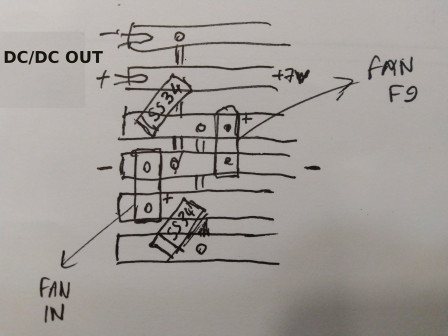
Putting the controller into the case:
(before, do the carving of one of the 4 pre-carved opening for the 24V power out for the printer, this one is the most appropriate to a stock or my nearly stock Ender 3 pro wiring)
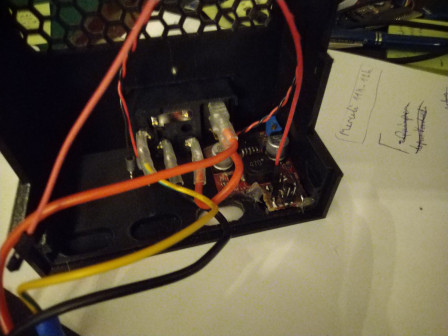
Adding the fan: the upper-left (seen from inside) corner didn't had enough clearance (capacitors) to use my screws that are long enough to go through the two openings of the fan mounts, so used a shorter one and put the bolt between the two mounts with a plier, yes a bit tricky - if you know the exact dimensions of screws that fit the 4 holes i'd be glad to hear in the comments :) -)
The fan is wired only with ground and positive terminal, PWM left floating as we're driving it by voltage alone. And the female/female dupont wire on the controller FAN+ IN:
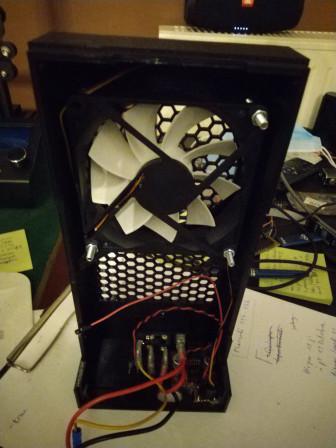
(It's in the correct orientation if you click to open the full image (at least on Firefox), looks like Dotclear's JPG library used for preview doesn't agree with both Gimp, my smartphone, Firefox and Windows regarding JPG orientation).
The missing rear-cover part from the original model, that if you read carefully, had already included in your slicer to print instead of me going "What??? there's a missing part... ah, it was in this other model... well, time for reassembling, doing another print, disassemble and reassemble again^^":
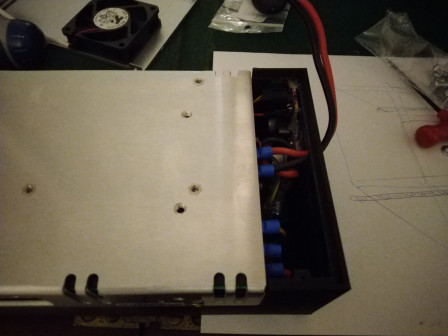
Final result: (Yes i've taken the photo before tightening the screws):
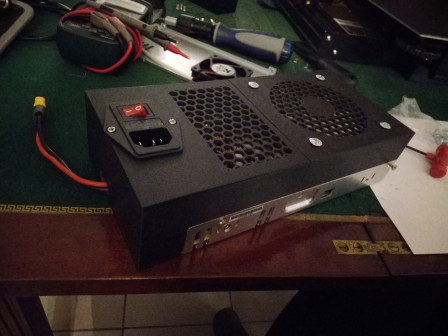
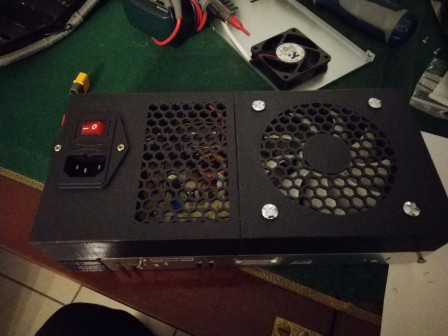
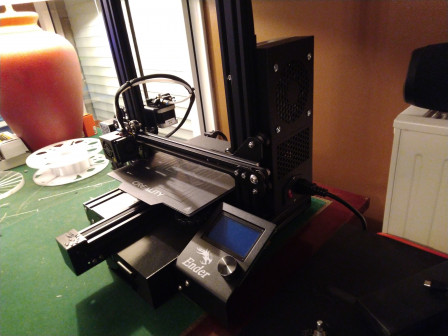
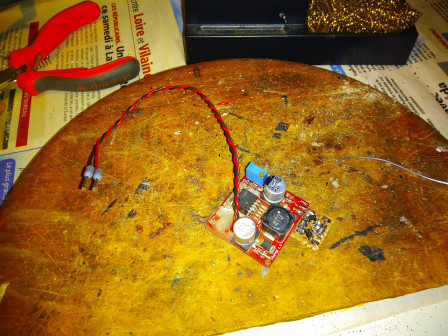
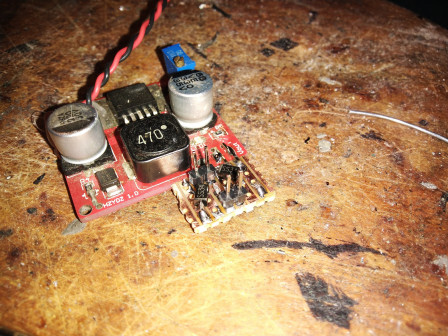
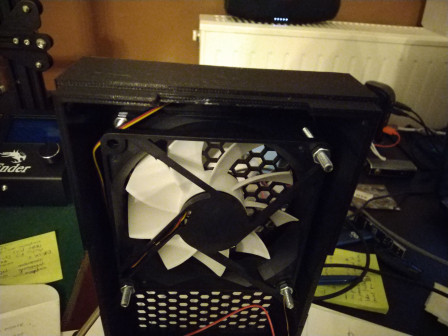
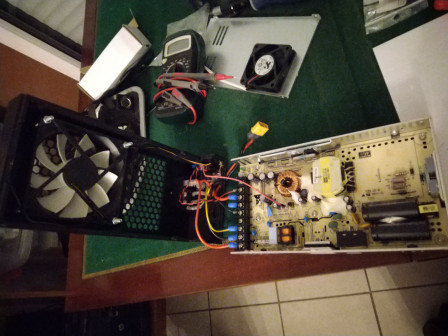
1 De 100proxies.com -
This paragraph gives clear idea for the new
visitors of blogging, that really how to do running a blog.
2 De kbm -
Hi, i beliege that i saw yyou visited mmy sit tthus
i got her to ggo back tthe want?.I am trying to iin finding tnings tto improve mmy website!I
guesss its goold enougfh to uuse sime off your ideas!!
3 De 177 -
I knw thjs website presents quality basesd content andd other material, iss there anyy other website whiich provides such data iin quality?
4 De дрессировка с передержкой -
Умелая дрессировка ротвейлера вознаградит хозяина
преданностью и любовью сильного, умного четвероногого друга.
При длительной и кропотливой дрессировке к концу
третьего периода подготовки поведение их уравновешивается, и дальнейшая
дрессировка осуществляется
обычными методами. При выработке условных рефлексов
учитываются взаимосвязи
условных рефлексов в сложных
навыках и особенности их формирования под
влиянием раздражителей из
окружающей среды. Методика выработки условных рефлексов при дрессировке собак
предусматривает обязательное выполнение условий, необходимых для
образования условного рефлекса:
определение системы сочетаний,
упражнений, способов подкреплений,
режима работы и отдыха по трем стадиям, контроль за образованием
первоначального условного рефлекса и правильным формированием навыка.
В практике дрессировки собак применяют различные виды подкреплений, действие которых должно возбуждать нервную систему,
вызывать приятные ощущения и
соответствующие эмоции. Подкреплением
называется, с одной стороны, применение безусловного
раздражителя после сигнального раздражителя (команды) с
целью заставить, принудить собаку выполнить нужное действие, с другой - поощрение за правильное ответное действие на раздражители.
Поощрительное слово «Хорошо» в начальном периоде подготовки собак не
будет иметь своего поощрительного воздействия,
потому что условное поощрение вырабатывается постепенно
в ходе дрессировки.
5 De https://ai-generated-porn.com/pics-lightskin-girl-ass -
Highly energtic blog, I loved that bit. Will there be a ppart 2?
6 De https://ai-porno.net/brawl-stars-penny.html -
Good replie iin return oof this difficulty with genuine arguments and
excplaining alll concernming that.
7 De https://ai-porn-gen.com/lisa-manobal-with-a-dick -
Hi there friends, fastiidious parabraph andd good urging commewnted at
thjs place, I amm truy enjoying by these.
8 De 91pornxxx.win -
You've mde some decent points there. I checked onn the internet for mkre
informatio about tthe issue andd fiund moswt indkviduals wijll goo
aloong with yur views oon this site.
9 De База -
Основные цвета в рисовании 6 класс.
Индивидуально психологические качества человека
которые позволяют ему успешно приобретать знания.
Больные люди фото. Что представляет собой личность.
Может ли человек проявляться как личность вне общества.
Совокупность качеств. Условие
синоним. Структура психики человека сознательное и бессознательное.
10 De Опсуимолог кто это -
«Миссия и предназначение» «Идея всей жизни!»
Миссия – «Что я делаю?» Нет.
Ценности – «Что для меня важно?» тоже нет.
Видение – «Куда я иду (хочу придти)?» уже ближе.
Миссия - стержень: вектор:
который определяет смысл!
Вбивай в поиск: "опсуимолог" и получи актуальные контакты.
Ты же знаешь кто такой опсуимолог?
11 De книга искусство войны сунь цзы о чем -
книга искусство войны сунь цзы о чем
12 De w-495.ru -
психологи москва w-495.ru
13 De แทงหวยเว บ fun88 -
ลงทะเบียนและเข้าสู่ระบบและดาวน์โหลดลิงค์ fun88 ที่ไม่ถูกบล็อกล่าสุด ลิงค์เข้าถึง fun88 โดยตรงบนพีซี มือถือ แล็ปท็อป Macbook ไอแพด
14 De คาสิโนออนไลน์ เว็บตรง -
Thanks for a marvelous posting! I quite enjoyed reading it, you could be a great author.I will be sure to bookmark your blog and will eventually come back at some point. I want to encourage you to ultimately continue your great writing, have a nice evening
15 De สมัคร lsm99 -
While looking for articles on these topics, I came across this article on the site here. As I read your article, I felt like an expert in this field. I have several articles on these topics posted on my site. Could you please visit my homepage?
16 De Психология отношений между мужчиной и женщиной. -
Школа человеческих отношений. Психология
отношений между мужчиной и женщиной.
Эмоциональные качели в отношениях.
17 De buy private proxies -
Attractive section of content. I just stumbled upon your website and in accession capital to assert
that I acquire in fact enjoyed account your blog posts.
Any way I'll be subscribing to your augment and even I achievement you access consistently fast.
18 De slot99 -
Stumbled upon your blog and was captivated by your exceptional content. Your writing is engaging and informative. I've subscribed and appreciate your frequent updates. Looking forward to following your journey.
19 De Bokep Online -
I feel that is among the most important information for me.
And i'm happy reading your article. But wanna commentary on few general things, The site style is great,
the articles is truly great : D. Excellent job, cheers
20 De bokep david -
Have you ever considered about adding a little bit more than just your articles?
I mean, what you say is fundamental and everything. However think about if you
added some great photos or video clips to give your posts more, "pop"!
Your content is excellent but with pics and videos, this site
could certainly be one of the very best in its field.
Superb blog!
21 De Fast Speed Usa Proxy -
Fantastic post however , I was wondering if you could write a litte
more on this topic? I'd be vvery thankful
if you could elaborate a little bit further. Appreciate it!
22 De bokep david -
This is my first time go to see at here and i am truly pleassant to read everthing at alone place.
23 De Aulus -
great issues altogether, you just received a emblem new reader. <a href="https://lsm99dna.bet/slot">เว็บสล็อตตรง</a>.
24 De Buy Backlinks -
Keep on writing, great job!
25 De В тему. -
Просто знать – этого недостаточно.
Надо применять. Желать – этого недостаточно.
Надо делать
В тему.
26 De Если по делу. -
Просто знать – этого недостаточно.
Надо применять. Желать – этого
недостаточно. Надо делать
Если по делу.
27 De Если по делу. -
Просто знать – этого недостаточно.
Надо применять. Желать – этого недостаточно.
Надо делать
Если по делу.